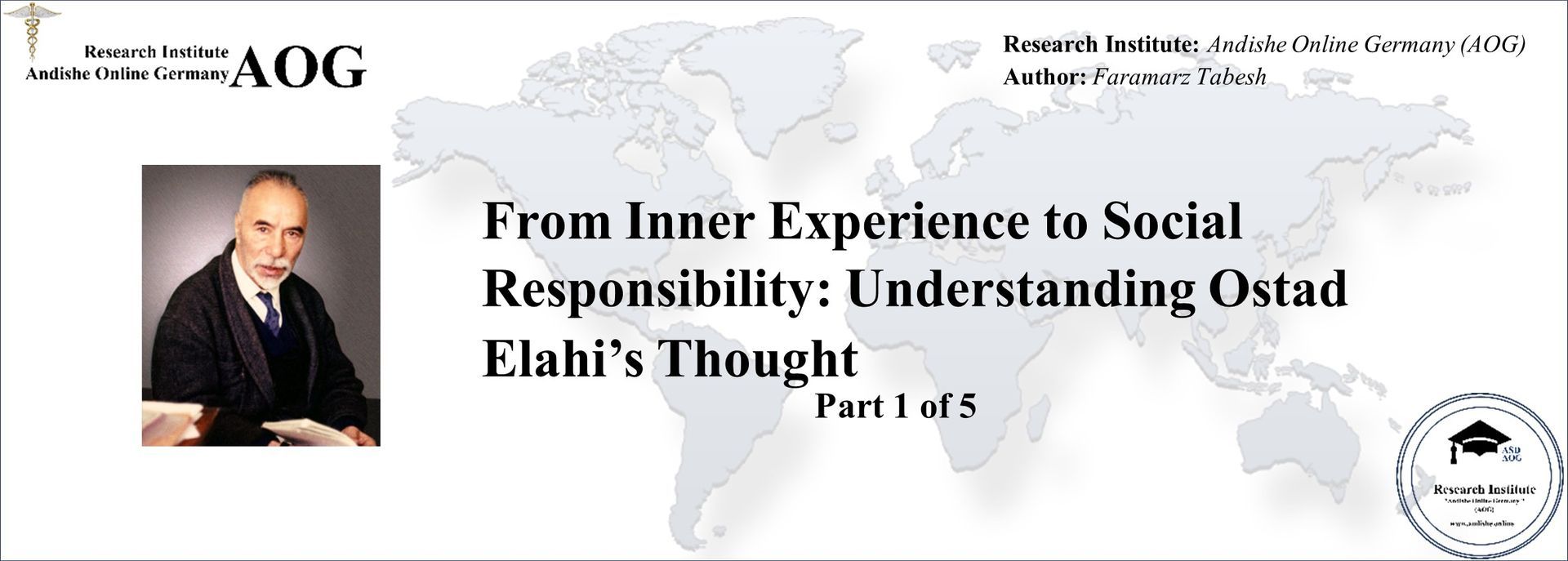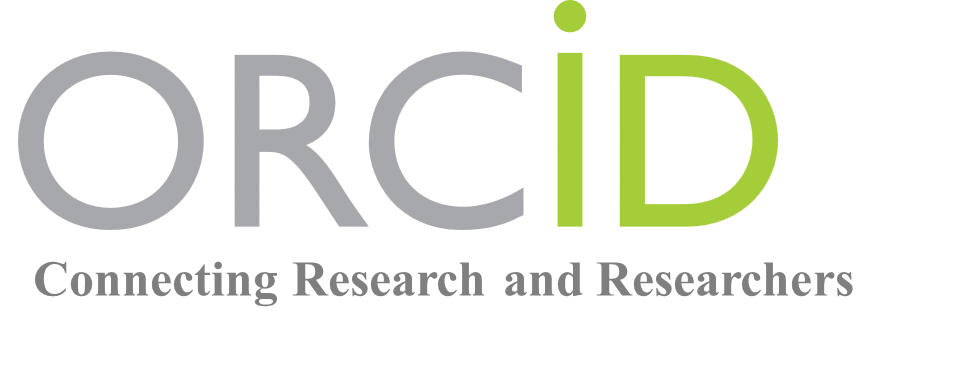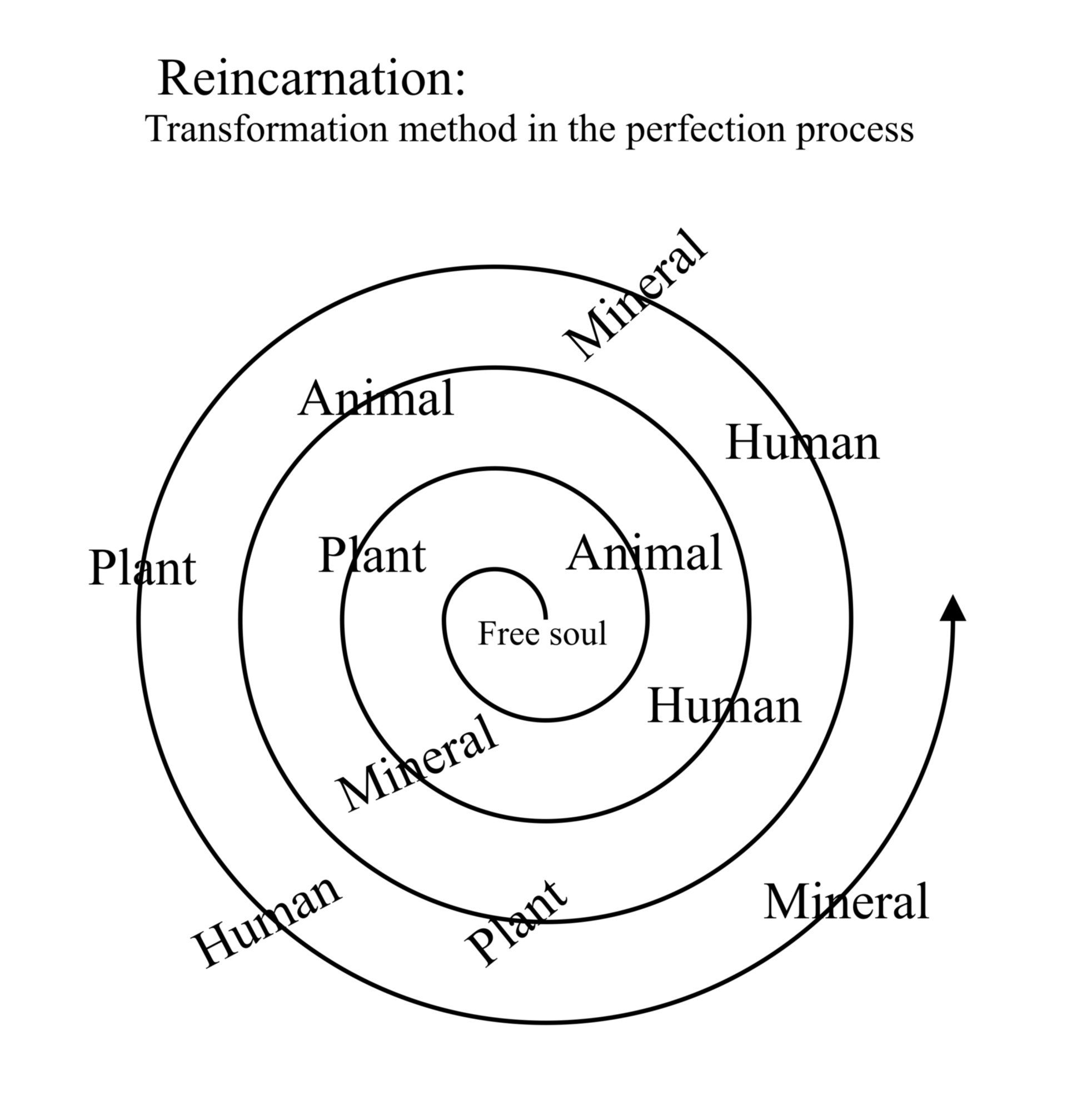Audio format article for the visually impaired at the bottom of the page


Paper Information
Research Institute: Andishe Online Germany (AOG)
Author: Faramarz Tabesh
This research is presented in five parts (Part I to Part V) and is available in English, German, Persian, French, Spanish, and Arabic.
Section: Excerpt from "Biography"
Subject Area: Interdisciplinary Research – Human Consciousness, Transpersonal Psychology, and Spiritual Development
Original Language: Persian (Farsi)
Persian Version (Part 1) – Release Date : Edition 16 / 2018
English Version – Initial Release: Edition 31 / 2020
English Version – Revised on: May 20, 2025
Translation: Translated into English and German by the author
Archival Code: fd, ävhtd t, k hsjhn hgid-hkägdsd
Part 1 of 5
Biography

Part No.1
Biography of Ostad Elahi
Part No.2
The divine discoveries
Part No.3
Philosophers and scientists in search of truth
Part No.4
Quantum mechanics
Elementary particle physics
The metaphysical thoughts
Part No.5
Ostad Elahi solved the riddle
..................................................
Integrated sciences
Article No.6
3 quantum dimension of matter
3.1 Tokyo experiment
Master Elahi (1895–1974), known as Ostad Elahi
Before we approach the primary topic of the „Biology of Quantum Dimension”1, we must first address the question: Who was Ostad Elahi?
The following information is drawn from published biographical sources2.
Master Nur Ali Elahi, internationally known as Ostad Elahi, was born on September 11, 1895, in Jeyhunabad, western Iran. He was raised in an environment imbued with a deeply spiritual atmosphere. His father, Haj Nemat3, was a prominent figure within a respected spiritual tradition known as the Ahl-e Haqq. Ostad Elahi emerged as a modern thinker, philosopher, and mystic—a distinguished musician and the inheritor of a centuries-old spiritual heritage.
Professionally, he served as a judge and, in parallel with his legal career, developed a spiritual system he described as the "quintessence of all divine religions."4 This system emphasizes both the material and what he termed the quantum dimensions of human beings5.
"Each person must, in daily activities, maintain balance between four essential aspects: the beyond and earthly life, and the soul and body." — Ostad Elahi
The spiritual system developed by Ostad Elahi enables the soul to progress toward perfection in a faster, more comprehensive, and less risky manner. Ostad explicitly states that anyone who wishes to embark on the path of spiritual perfection must necessarily engage with the material world in order to gain the experiential knowledge6 required for this journey. He firmly rejects isolation and withdrawal from society, as such detachment prevents the application of the essential “experience and implementation” process necessary for soul development.
This process emphasizes several core priorities that the spiritual seeker must unconditionally learn and apply. Attaining spiritual perfection is a long-term endeavor that continues beyond physical death. A key requirement is that the soul must return to this world multiple times over a certain period7, until it reaches a specific level of spiritual maturity.
This form of return—clearly defined, described, and termed by Ostad Elahi as "the process of perfection through the ascending method," —differs fundamentally from conventional notions of reincarnation. One key difference is as follows:
- According to the doctrine of reincarnation
The soul of a living being is believed to reappear immediately after physical death, either in the body of a newly created human or animal—one that is either soulless or newly formed. There is no limit to the number of such rebirths, and the soul may inhabit any mineral, plant, animal, or human body that lacks a soul. However, according to the teachings of perfection through the ascending method, such a scenario is entirely implausible. As elaborated later in this work, every manifest entity necessarily possesses a soul. Moreover, reincarnation imposes no time constraints on the recurrence of such embodiments.
- According to Ostad Elahi’s teachings
The reappearance of the soul in another life and body always follows a continuous and ascending trajectory. For instance, a plant soul does not reincarnate as a mineral but instead reemerges at a higher level within the plant kingdom—or, under specific conditions, in a basic form of animal life. Such transformations never occur in isolation but involve multiple souls of relatively equal rank8 manifesting together. Furthermore, these transitions occur within a defined timeframe.
It is important to note that Ostad Elahi’s teachings on this topic are far more comprehensive than what is briefly summarized here. I intend to explore and explain this subject in depth elsewhere. The specific disciplines, conditions, and frameworks required for a soul to complete the process of perfection constitute an entire field within his teachings—one that exceeds the scope of this current article series and requires a dedicated, separate study.
Spiritual Perfection: Ascending Method vs. Reincarnation
Musical Genius
Ostad Elahi was also an extraordinary composer and musician. When he first began playing the tanbur, he was so young that his hands could not even reach around the frets of a standard instrument. Through years of consistent practice under the guidance of master musicians—and due to his exceptional natural talent9—he achieved complete mastery of Kurdish, Luri, Persian, Turkish, Arabic, and Indian musical traditions by the age of six.
Although the tanbur remained his favored instrument, he was also proficient in others, including the tar, setar, violin, daf, and chagur.
Ostad Elahi never performed in public; he played only for his students and close family members. Nevertheless, his reputation reached beyond Iran’s borders. Several internationally renowned musicians, such as Maurice Béjart10 (1927–2007), the French ballet dancer and choreographer, and Yehudi Menuhin11 (1916–1999), the American violinist and conductor considered one of the greatest virtuosos of the twentieth century, visited him in Iran and were deeply moved by his music.
Jean During12, professor of ethnomusicology and Oriental studies, wrote a book about Ostad Elahi’s unique musical approach titled “L’Âme des sons: L’art unique d’Ostad Elahi.“13
Several other scholars have explored his work. For instance, Professor James Winston Morris14 of Boston University translated and published one of Ostad Elahi’s books under the title Knowing the Spirit (Paraview, 2005). Another scholar, Professor Saint Waitman15 of the University of London, translated Borhān al-Ḥaqq16 into English.
Conclusion
What has been described above about Ostad Elahi and his teachings represents only a small portion of a much broader subject. A significant part of his doctrine includes detailed explanations and descriptions related to the origin of creation and the fundamental laws governing existence.
Ostad Elahi’s teachings offer comprehensive answers to the core questions humanity has grappled with for millennia—questions such as: Who is the human being, and where does he come from? What is he made of? What is his purpose in the material world? These and other fundamental topics will be examined and analyzed in detail, one by one, in the following sections.
Writing a comprehensive biography of Ostad Elahi requires in-depth research that considers all dimensions of his character and life.
End of Article 1 of 5

Faramarz Tabesh
Archiving Code for This Part: fd, ävhtd t, k hsjhn hgid-hkägdsd
Part 2 of 5: The Divine Discoveries
References
1. This is the title of the first book I, Faramarz Tabesh, have written to develop a unified science, in which I attempt to integrate the master's teachings with academic disciplines, particularly biology, particle physics, and quantum mechanics. The full title of the book is: Biology of the Quantum Dimension: Before, During, and After the Big Bang.
2. This subject has been extensively discussed in articles published by the AOG Research Institute on the scientific teachings of Ostad Elahi.
3. Hajj Nematullah was the father of Ostad Elahi and one of the prominent leaders of the Ahl al-Haqq mystical group. While this group has followers worldwide, its primary base remains in the Kermanshah and Kurdistan provinces of Iran. His famous work, The Book of the Kings of Truth (Shahnameh-e Haqiqat), was translated into English by James Morris and published by Brill in 2008.
4. This article is presented in two parts on the AOG Research Institute websites, available in six languages. In English, see: Part One of the article and Part Two of the article.
5. This refers to the true self. See explanation number 8 for further details.
6. It should be noted that the progression toward soul perfection must begin with earthly life. Only through confronting contradictions can the soul come to truly grasp the deeper meaning of good and evil. For further context, see explanation number 7.
7. According to the teachings of Ostad Elahi, a soul has 50,000 earthly years to achieve ultimate perfection. Since every two earthly lives together are meant to last only 100 years, each soul has a maximum of 1,000 earthly lifetimes to fulfill this purpose.
9. The Spiritual Teachings of Master Nur Ali Elahi. Translated by James W. Morris. New York: Paraview, 2005. See Chapter 1, pp. 12–15. In pages 12 to 15 of Chapter 1, Morris discusses Master Elahi’s musical talent, his mastery of various regional and traditional musical styles, and the role of music in his spiritual journey.
10. Béjart, Maurice. Ma vie en mouvement. Paris: Robert Laffont, 1996.
11. Menuhin, Yehudi. Unfinished Journey. New York: Knopf, 1977.
12. During, Jean. L’Âme des sons: L’art unique d’Ostad Elahi. Paris: Albin Michel, 2001.
13. The Soul of Sounds: The Unique Art of Ostad Elahi
14. Elahi, Nur Ali. Knowing the Spirit. Translated by James Winston Morris. New York: Paraview Press, 2003.
Morris, James Winston. “Spiritual Self and the Journey to Perfection in the Thought of Ostad Elahi.” Journal of Islamic Mysticism, vol. 15, no. 2, 2004, pp. 187–210.
15 16^. Elahi, Nur Ali. Borrhān al-Ḥaqq (Demonstration of the Truth). Translated by Saint Waitman. London: Institute of Oriental Philosophy, 1995.
Elahi, Nur Ali. Spirituality is a Science. Unpublished lectures and notes, archived at the Elahi Foundation, Paris.
Article in YouTube (V1)
"V2 is not available."
Audio format article for the visually impaired (V1)
"V2 is not available."








